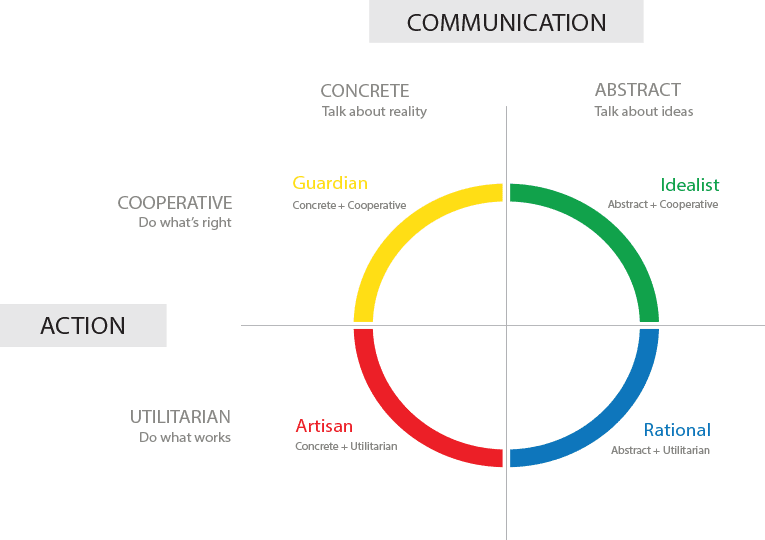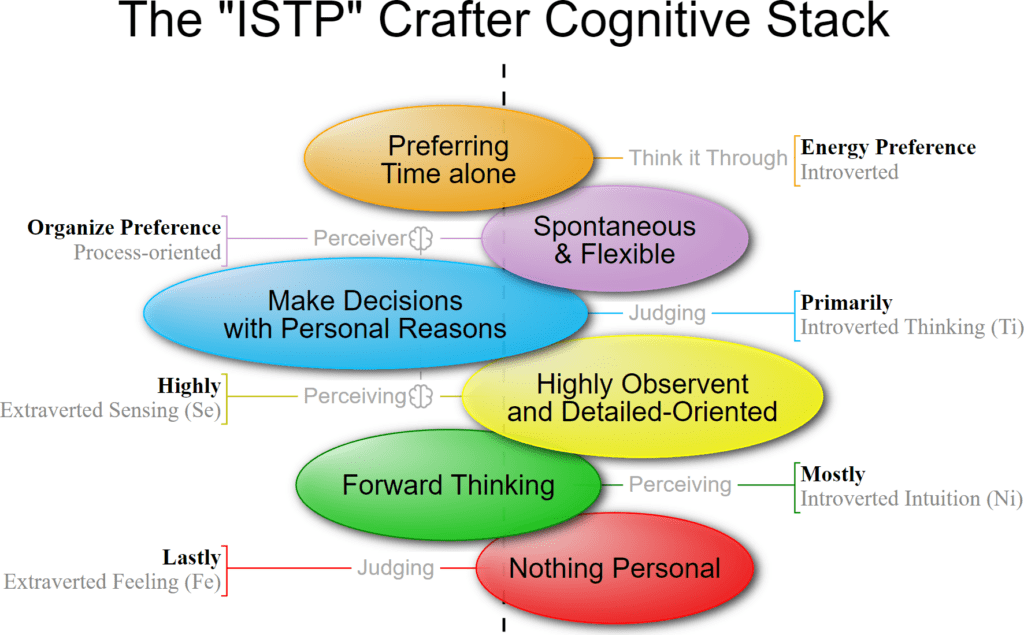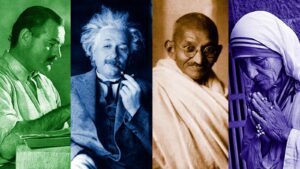What is the Keirsey ISTP “Crafter” Personality Type?
The Keirsey ISTP “Crafter” Personality Type is an Artisan Temperament with a Concrete Communication Style and a Utilitarian Action Style.
Keirsey organized the Four Temperaments as a matrix. There are two communication styles, abstract and Concrete, similar to the Myers-Briggs Intuition (Abstract) and Sensing (Concrete) “Perceiving” Cognitive Functions.
And by two action styles: cooperative and utilitarian. Utilitarian people, for the most part, do what works, while Cooperative people do what’s right.
Keirsey named the Four Temperaments as suggested by Plato: Artisan (Iconic), Guardian (Pistic), Idealist (Noetic), and Rational (Dianoetic).

Concrete versus Abstract Communication Style
Keirsey divided the Four Temperaments into two Communication Styles: Abstract and Concrete. These styles resemble the Myers-Briggs Intuition and Sensing “Perceiving” Cognitive Functions.
Some people talk primarily about everyday reality’s external, concrete world: facts and figures, work and play, home and family, news, sports, and weather—all the who, what, when, where, and how of life.
Other people talk primarily about the internal, abstract world of ideas: theories and conjectures, dreams and philosophies, beliefs and fantasies—all the whys, ifs, and what might be of life.
Concrete people talk about reality in their daily lives, while Abstract people talk about ideas.
According to Keirsey, everyone can engage in both observation and introspection. People are observant when they touch objects or otherwise perceive the world through their five senses. When people reflect and focus on their internal world, they are introspective. However, individuals cannot engage in observation and introspection at the same time. The extent to which people are more observant or reflective affects their behavior.
People who are generally observant are more ‘down to earth.’ They are more concrete in their worldview and focus on practical matters such as food, shelter, and their immediate relationships. Carl Jung used the word sensation when describing people who prefer concrete perception.
Generally, reflective people have more ‘heads in the clouds’ and abstract worldviews. They focus on global or theoretical issues such as equality or engineering. Carl Jung used the word intuition to describe people who prefer abstract perception.
Cooperative versus Utilitarian Action Style
Some people act primarily practically or pragmatically; that is, they do what gets results, what achieves their objectives as effectively or efficiently as possible. They only check afterward to see if they observe the rules or go through the proper channels.
Other people act primarily cooperatively or socially acceptable; they try to do the right thing in keeping with agreed-upon social rules, conventions, and codes of conduct. Only later do they concern themselves with the effectiveness of their actions.
These two ways of acting can certainly overlap, but as they lead their lives, utilitarian people mostly do what works, while cooperative people do what’s right.
Keirsey compares the differing temperaments with cooperative (Complying) and pragmatic (Adaptive) temperaments. Cooperative people pay more attention to other people’s opinions and are more concerned with doing the right thing. Sensible people (Utilitarian) pay more attention to their thoughts or feelings and are more concerned with doing what works. No comparable idea in the MBTI or Jung corresponds to this dichotomy, which is a significant difference between Keirsey’s work and Myers and Jung’s.
The pragmatic temperaments are Rational (pragmatic and abstract) and artisan (Pragmatic and concrete). The Cooperative Temperaments are Idealists (Cooperative and Abstract) and Guardians (Cooperative and Concrete). Neither the MBTI nor Jung included the concept of Temperament in their work.
ISTP Keirsey/MBTI Correlation
| Keirsey | MBTI | |
|---|---|---|
| I | Attenative Role Variant | Introverted Thinking |
| S | Concrete Communication Style | Extraverted Sensing Auxiliary Function |
| T | Directive Role | Introverted Thinking Dominate Function |
| P | Utilitarian Action Style | Sensing is a Perceiving Function |
With Extraverted Sensing as the second Auxiliary Function and Introverted Thinking as the first Dominant Function, the MBTI ISTP “Crafter” Personality Type sorts to the Keirsey ISTP “Crafter” Personality Type.

ISTP Personality Type cross-reference
- Keirsey Type – Crafter
- Temperament Type – Sanguine
- Animal Type – Golden Retriever
- DISC Type – Steadiness
- Socio-Communicative Type – Amiable
- True Colors – Orange
- Color Code – Yellow
- Personality Compass – South
- Occupational Type – Conventional
- Learning Type – Reflector
- Leadership Type – Accommodator
Enneagram Types
Crafter Personality Characteristics
Crafters use tools in some capacity and are the true masters of toolwork. They have an innate ability to command tools and become experts at all the crafts requiring tool skills.
Even from an early age, children are drawn to tools. Magnett tools fall into their hands, demanding use, and they must work with them.
Like all the Artisans, Crafters love action and know instinctively that their activities are more enjoyable and more effective if done impulsively, spontaneously, and subject to no schedules or standards but their own.
In a sense, Crafters do not work with their tools but play with them when the urge strikes them.
Crafters also seek fun and games on impulse, looking for any opportunity, and just because they feel like it, to play with their various toys: cars, motorcycles, boats, dune- buggies, hunting rifles, fishing tackle, scuba gear, and on and on.
They thrive on excitement, particularly the rush of speed racing, water skiing, and surfing.
Crafters are fearless in their play, repeatedly exposing themselves to danger despite frequent injury. Of all the types, Crafters are most likely to be risk takers, pitting themselves or their technique against chance or odds.
Crafters are hard to get to know. Perhaps this is because they communicate through action and show little interest in developing language skills.
Their lack of expressiveness can isolate them at school and on the job. Even though they hang around with their kind in play, they let their actions speak for them, and their actual conversation is sparse and brief.
Crafters can be generous and loyal to their friends, teammates, and sidekicks. They often give up their evenings or weekends to help with building projects or mechanical repairs, remodeling, or working on cars or boats.
On the other hand, they can be fiercely insubordinate to those in authority, seeing rules and regulations as unnecessarily confining. Crafters will not usually go against laws openly but will ignore them.
More than anything, Crafters want to be free to do their own thing, and they are proud of their ability to do it with an artist’s skill.
Famous Crafters
Bruce Lee, Michael Jordan, Woody Allen, Alan Shepard, Chuck Yaeger, Michael Douglas, Lance Armstrong, and Kathrine Hepburn are examples of Crafter Artisans.

What are the Keirsy Personality Temerpaments?

David Keirsey, born in 1921, was an American psychologist specializing in conflict management and family counseling. He began researching human behavior and Personality in the 1940s.
Keirsey blended the Myers-Briggs Personality Types with Ernst Kretschmer’s model of the Four Temperaments, developing the Keirsey Temperament Sorter, which was made famous by his book “Please Understand Me.”
Instead of using the term Personality, Keirsey used Temperament. He viewed it as a configuration of observable Personality Traits, communication habits, patterns of action, characteristic attitudes, values, and talents. To Keirsy, Temperament encompasses personal needs, individual contributions, workplace contributions, and societal roles.
Keirsey correlated the sixteen MBTI Personality Types into Four Temperaments. He divided each Temperament into two Roles: informative and Directive. He subdivided the roles into expressive (extraverted) and attentive (introverted) role Variables.
Informative versus Directive Roles
Keirsey distinguishes between people who generally communicate by informing others versus those who speak by directing others. This distinction subdivides each of the four Temperaments into eight Roles.
Expressive versus Attentive Role Variants
Individuals who act before observing are Expressive. In contrast, people who follow before working are Attentive.
Expressive and attentive variants further subdivide the eight roles into 16 types correlating to the 16 Myers-Briggs personality types.


